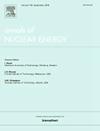Evaluation of different external neutron sources for a hybrid system based on the SEALER reactor
IF 1.9
3区 工程技术
Q1 NUCLEAR SCIENCE & TECHNOLOGY
引用次数: 0
Abstract
This work analyzed a hybrid modular system based on the SEALER. The original SEALER core has been modified to design the subcritical system for actinides transmutation. In this modification, the central fuel assembly was replaced with a lead target and an external neutron source, a crucial component that facilitates the transmutation process, and the UO2 fuel, originally enriched to 19.75 %, has been substituted with reprocessed spent fuel. Two external neutron sources have been evaluated: a fusion neutron source based on an isotropic source with a deuterium–tritium (2H–3H) neutron spectrum calculated according to the plasma specifications of the Affordable Robust Compact (ARC) type tokamak reactor and a neutron source produced from spallation reactions with a natural lead target. The main goal was to evaluate the possibility of the hybrid system transmuting different reprocessed fuels: oxide-based spiked with thorium and depleted U ((TRU,Th)O2 and (TRU,DU)O2) and also nitrites spiked with the same elements ((TRU,Th)N e (TRU,DU)N). The results showed its possible viability.
求助全文
约1分钟内获得全文
求助全文
来源期刊

Annals of Nuclear Energy
工程技术-核科学技术
CiteScore
4.30
自引率
21.10%
发文量
632
审稿时长
7.3 months
期刊介绍:
Annals of Nuclear Energy provides an international medium for the communication of original research, ideas and developments in all areas of the field of nuclear energy science and technology. Its scope embraces nuclear fuel reserves, fuel cycles and cost, materials, processing, system and component technology (fission only), design and optimization, direct conversion of nuclear energy sources, environmental control, reactor physics, heat transfer and fluid dynamics, structural analysis, fuel management, future developments, nuclear fuel and safety, nuclear aerosol, neutron physics, computer technology (both software and hardware), risk assessment, radioactive waste disposal and reactor thermal hydraulics. Papers submitted to Annals need to demonstrate a clear link to nuclear power generation/nuclear engineering. Papers which deal with pure nuclear physics, pure health physics, imaging, or attenuation and shielding properties of concretes and various geological materials are not within the scope of the journal. Also, papers that deal with policy or economics are not within the scope of the journal.
 求助内容:
求助内容: 应助结果提醒方式:
应助结果提醒方式:


